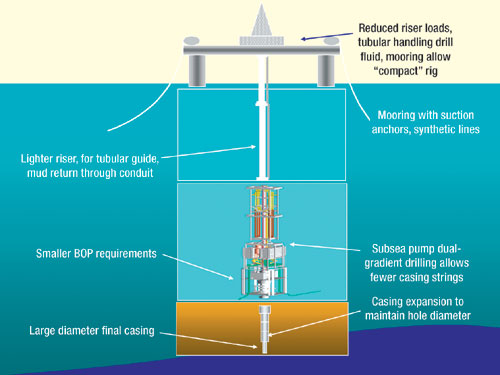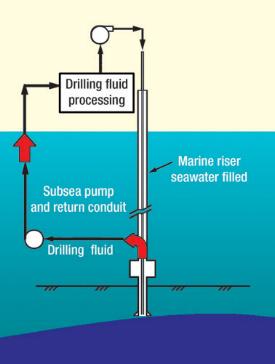|
Jan.
2002 Vol. 223 No. 1
Feature Article
|
DEEPWATER TECHNOLOGY
Upcoming technology developments
 n
his presentation, which he called "Delivering tomorrow," Paul Goodfellow covered: deepwater GOM
technology drivers; use of subsea pumps to create dual-density drilling; pre-installed moorings; and
applications of surface BOPs on floating rigs. He then summarized the status of the technology he discussed,
along with potential cost savings. He also discussed the evolution of slender wells using expandable tubulars
– this subject is covered in more detail in a separate presentation, as are surface BOPs. n
his presentation, which he called "Delivering tomorrow," Paul Goodfellow covered: deepwater GOM
technology drivers; use of subsea pumps to create dual-density drilling; pre-installed moorings; and
applications of surface BOPs on floating rigs. He then summarized the status of the technology he discussed,
along with potential cost savings. He also discussed the evolution of slender wells using expandable tubulars
– this subject is covered in more detail in a separate presentation, as are surface BOPs.
Deepwater GOM technology drivers. Several basic
problems common to deep water include:
- Wells in geopressured environments require many
casing strings.
- The number of casings, hole size and completion
needs drive BOP and wellhead size.
- Riser, mooring and deck loads drive hull size, thus
drill vessel size.
- Well costs are driven primarily by: 1) rig dayrates
(for 5th generation rigs); and 2) time on the well (for 10 – 12 strings of pipe).
The opportunity is – reduce drill vessel costs and
improve drilling efficiency.
And well difficulty is increasing. Deeper water and
deeper well depths are requiring large hole diameters – up to 10-5/8-in. – at TD for optimum
production. These wells present higher temperatures / pressures. There is little or no difference between
drill fluid density needed and formation fracture gradients. And field developments in "frontier"
areas are more challenging / expensive, after successful exploration efforts.
A summary of deepwater technology development is
illustrated in Fig. 1. In the overall well / rig illustration, large-diameter production casing is needed for
high-rate completions in 20,000 – 30,000-ft wells. Casing expansion is a method to maintain larger hole
diameters. Dual gradient drilling using subsea pumps enables drilling with fewer casings.
 |
|
Fig. 1. Overview of SEPCo’s
deepwater well technology development program and objectives. |
|
Smaller BOPs are required, due to fewer casing strings
and hole diameter maintenance. The riser is lighter / smaller and serves only as a "guide" for
tubulars, as drill fluid is returned through the attached conduit. Mooring systems, suction anchors and
synthetic lines provide mooring in deeper water.
The technology pieces introduced above result in
reduced riser loads / size, less tubular handling, lower drill-fluid volumes, improved mooring and a surface
BOP. All of this enables a "compact" rig, which reduces drill vessel costs and improves drilling
efficiency.
Subsea pump, dual-gradient drilling. Fig. 2
shows schematically how a subsea pump takes drilling mud returning up the drill pipe-casing annulus and pumps
it up a separate conduit to the rig floor for processing. The riser above the pump is filled with seawater, so
only weight of the depth of seawater is added to mud weight in the hole, not the 7,000 ft or 10,000 ft of
drill mud in the riser’s annulus.
 |
|
Fig. 2. Schematic of subsea pump
returning drilling fluid up separate conduit to the rig from the mudline to create dual-gradient
drilling scenario. |
|
This effectively produces a mud gradient in the hole
relative to the mudline, vs. a gradient relative to surface. The bottom line is that it widens the distance
between mud weight and fracture pressure and allows greater distance between casing strings.
SEPCo’s subsea pumping system is currently being
constructed and will be deployed on the Transocean Sedco Forex
Deepwater Nautilus semi in 3rd or 4th quarter 2002. The pump features: minimal moving parts, limited
subsea control, a patented passive annular control and patented subsea mud separation.
Besides producing fewer casing strings, in the process
the subsea pump helps manage shallow flow problems that plague deepwater drillers. With subsea pumping, a
compact semi can be used. The initial part of the well can be drilled riserless with mud / cuttings pumped to
surface. Deeper portions can be drilled conventionally. Potential cost savings of up to 40% are possible.
Pre-installed mooring. As introduced above,
this is a method of making smaller vessels practical. Moorings for deepwater floaters using steel wire and
suction anchors have been successfully installed in 7,790-ft water. These systems require multiple boats and
submersible buoys. Steel-line weight limits water depth.
The first system with synthetic rope has been deployed
in 9,100-ft water, using a single boat; and the Deepwater Nautilus semi was hooking up in late 2001.
Advantages of the system are that: smaller rigs can be utilized; it extends the rig’s capabilities; and
moored rigs have deepwater capability formerly achievable only with dynamic positioning, with less
environmental emissions and fuel usage.
Other applications include suction anchor placement for
mooring system interference and seafloor congestion around installations such as subsea trees, umbilicals and
flowlines. 

 |
Shell’s
deepwater program: A broad-based technology commitment |
 |
Don Jacobsen,
Manager, Drilling & Completions, Shell Exploration & Production Co. (SEPCo), New Orleans; |
 |
Paul Goodfellow,
Drilling & Completions Operations Manager, Shell International Exploration E&P Inc., New Orleans;
|
 |
Ken Dupal, Sr.
Staff Drilling Engineer, SEPCo, New Orleans; and |
 |
Graham Brander,
Sr. Drilling Engineer, Shell International E&P Inc., Houston. Overviews of their presentations follow.
 |
|




